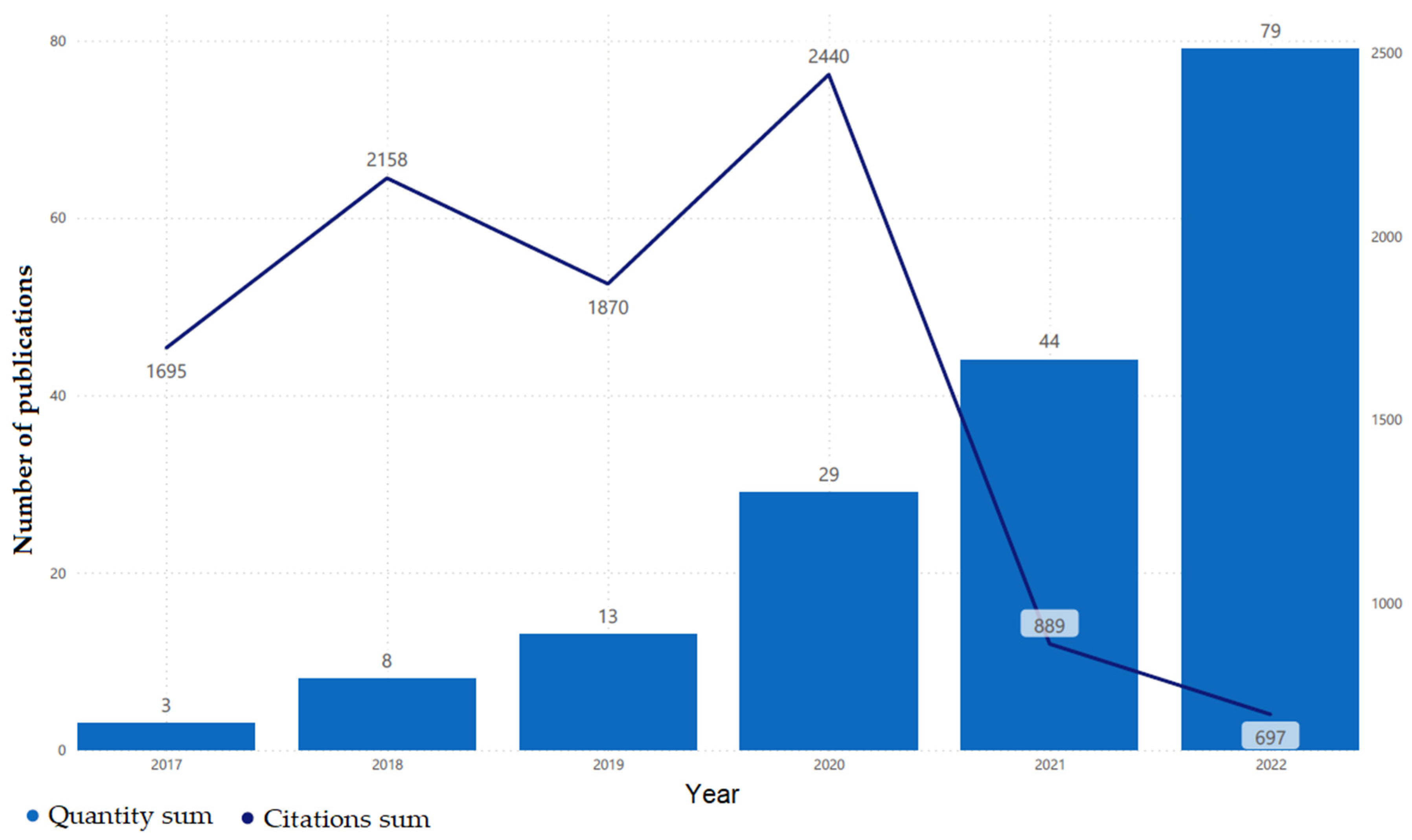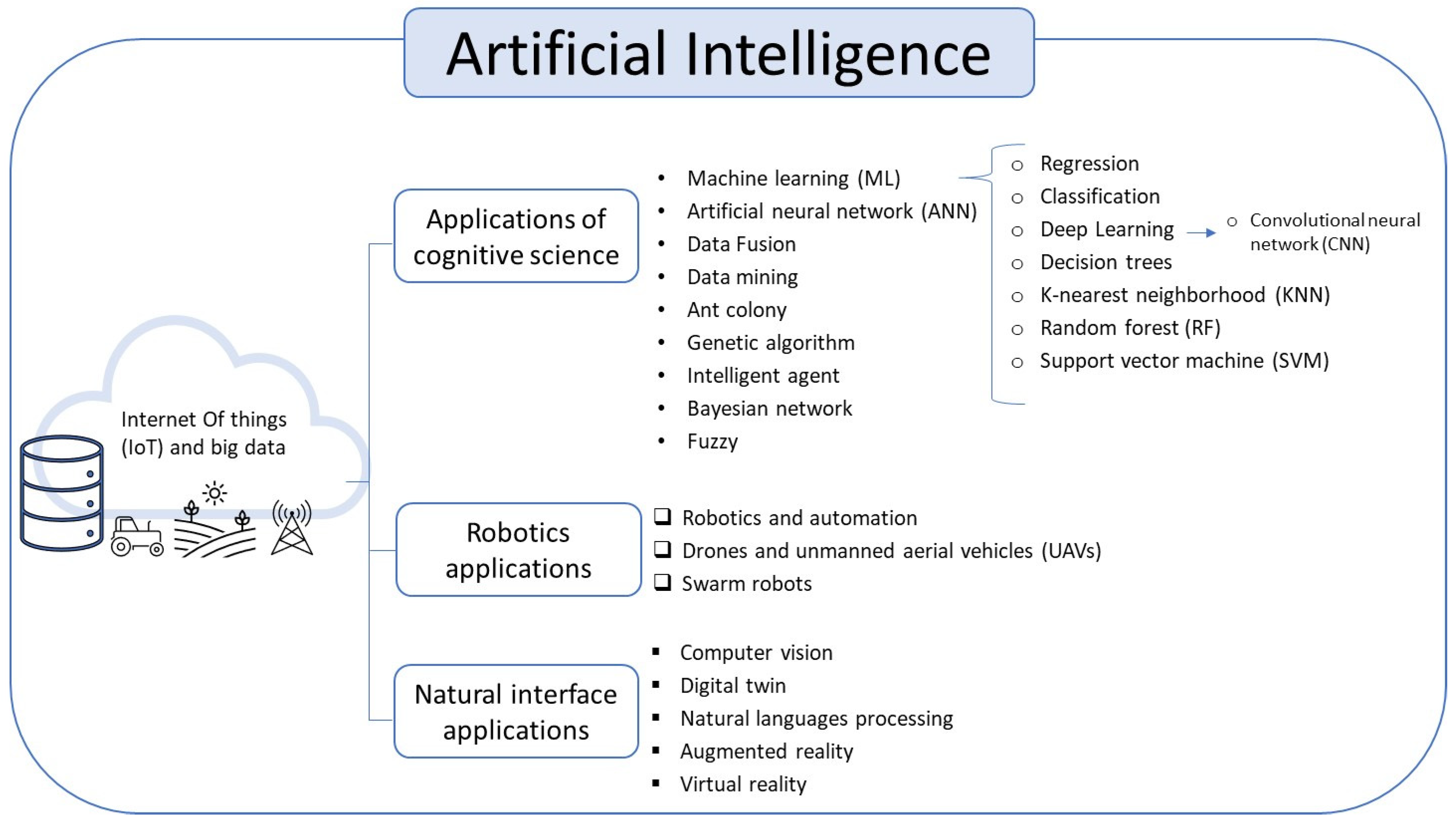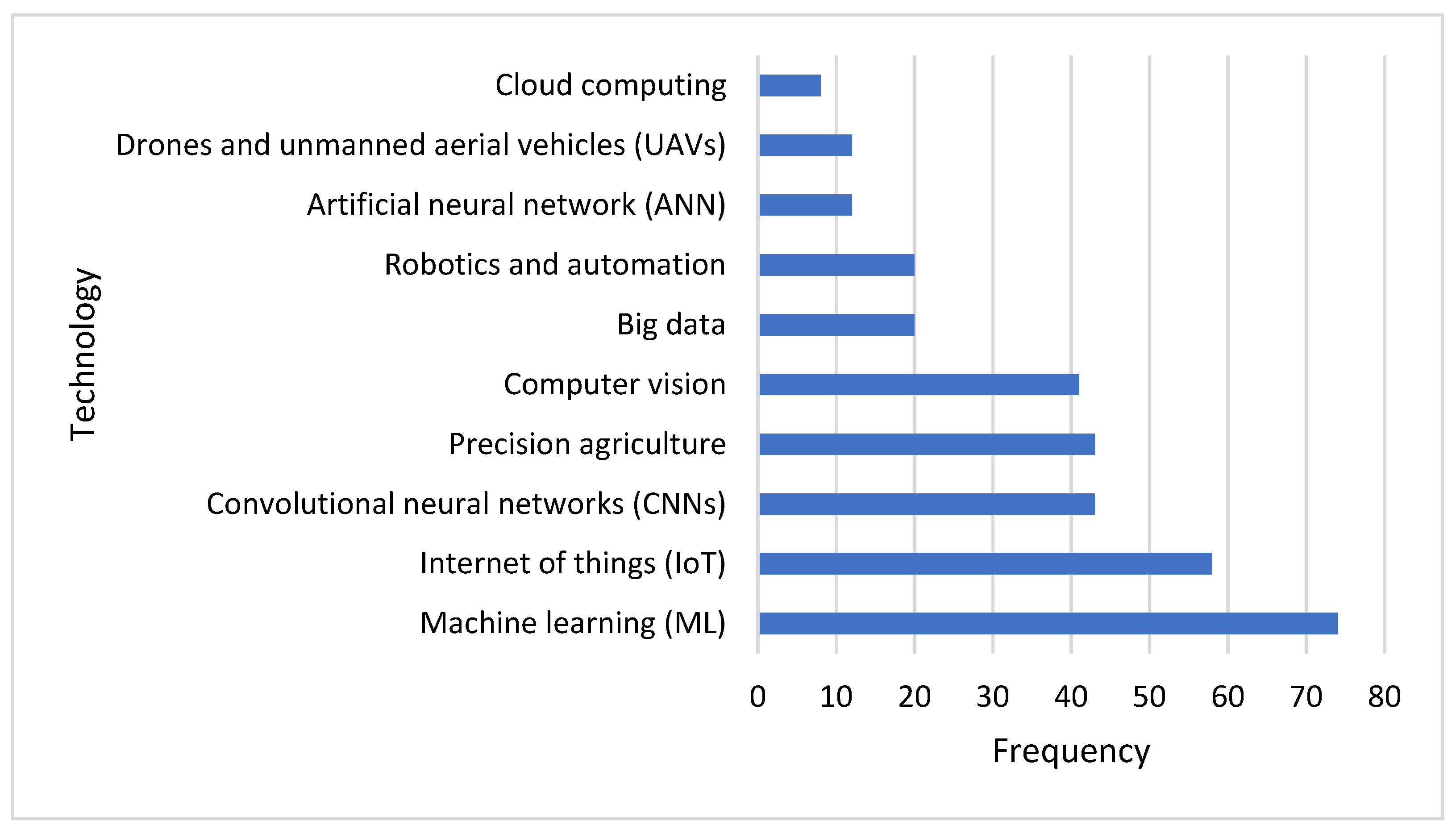1. Introduction
Geopolitical events are causing supply chain strains, and climatic events are impacting the food systems’ resilience [
1]. The challenges to ending hunger and food insecurities keep growing, and the COVID-19 pandemic has further highlighted fragilities in our agrifood systems and inequalities in our societies [
2]. This scenario becomes more urgent with the growing food demand. The Food and Agriculture Organization (FAO) has stated that by 2050 there will be around 10 billion people, and the food demand will grow by 70% [
3]. Artificial intelligence (AI) techniques applied in agriculture can optimize agricultural processes by food system resilience increases.
AI is an evolving set of technologies that are used to solve a variety of applied problems and has been extensively applied in farming recently [
4]. This work’s purpose is to make a systematic review of the current studies and research in agriculture that employ the recent practices of AI technologies to solve several relevant problems.
Reviews of the literature are important for synthesizing the existing knowledge base: in [
5], the authors conducted a review about crop yield prediction using machine learning; in [
6], advanced agricultural disease image recognition technologies were explored; IoT solutions for smart farming were researched in [
7]; big data in agriculture in [
8]; and agriculture 4.0 in [
9,
10]. This work presents extensive research on the latest application of AI in agriculture to alleviate problems in the seven main agriculture domains identified: crop management, water management, soil management, fertirrigation, crop prediction, crop classification, disease, and pest management. In the 176 studies selected for descriptive analysis, more than 20 different artificial intelligence techniques were identified. After the qualitative analysis, 17 articles were selected and described their application in agriculture, challenges, and benefits.
The outline of this paper proceeds with the research methodology, which follows the PRISMA steps with the selected criteria and data collected;
Section 3 presents the bibliometric analysis results;
Section 4 presents the relevant articles selected with a quality appraisal regarding their main agriculture domains and the AI technologies used;
Section 5 presents the challenges, benefits, trends, and research directions identified. Finally,
Section 6 shows some conclusions.
3. Descriptive Analysis (RQ1)
This section quantitatively describes the 176 selected studies considering the publications and citations volume; the method of the studies identified; and the most influential countries, journals, and institutions.
Figure 3 shows the distribution of papers and citations per year.
The publications number and citations in the area have tripled over the last three years; the data collected in December 2022, reached a peak of 2440, referring to the 2020 publications. That is, the 2021 and 2022, publications were already citing the 2020 publications, showing the dynamism of feedback from this line of research. Studies were classified as either theoretical or empirical (
Table 8). Theoretical studies were classified as reviews or SLRs. Additionally, empirical studies were classified as modeling and simulation, surveys, or case studies.
The number of studies was balanced, with 43% classified as theoretical and 57% as empirical. Theoretical studies had an emphasis on reviews of the literature, with 59 papers representing 34%, and in between empirical studies, these stood out in modeling and simulation, with 68 papers representing 39%. The most representative articles in quality appraisal steps reflect this distribution, such as [
13,
15] which developed, respectively, robot strawberry-picky and smart irrigation systems.
When studying a research paper’s relevance, bibliometric analysis can consider several indicators. This research shows the volume and impact of the publications concerning citation numbers. The Netherlands is the most influential country in this research scope, with 5 publications and 1629 citations, closely followed by India, with 37 publications and 1499 citations. Greece had only 3 publications and 1002 citations, and China had 23 publications with 899 citations.
Table 9 shows the countries with more than 100 citations.
Computers and Electronics in Agriculture led the ranking with 4206 citations and 55 publications, followed by Agricultural Systems (1195), Sensors (1012), and Artificial Intelligence in Agriculture (592).
Table 10 shows the Journals with more than 100 citations; those with the greatest impact factor are Computers in Industry (11.245), IEEE the Internet of Things Journal (10.238), Computers and Electronics in Agriculture (6.757), Agricultural Systems (6.765), and Information Processing in Agriculture (6.409).
Table 11 shows the ten institutions with the highest citation volume. This ranking was led by universities from the USA, The Netherlands, three universities from China, India, Chile, and two universities from Malaysia and Brazil.
Finding 1: The publications and citations of artificial intelligence techniques applied to agriculture increased almost six times over the last three years, demonstrating the importance and timeliness of this research line. The most influential countries identified were among the world’s largest food producers, and there were different Journals with high-impact factors in publishing in this field.
4. Artificial Intelligence in Agriculture (RQ2)
Agriculture, meaning land cultivation, is the science of raising livestock and producing crops. The principal resource base for agriculture is the physical environment, and the cultivated crop plant is their production unit. The challenge of agriculture is to efficiently manage the physical environment to provide for the biological demands of the crop plant [
27]. The principal factors that impact crop yield are soil productivity, the accessibility of water, climate, and pests or diseases [
28].
4.1. Main Agriculture Domains
Artificial intelligence is transforming the agricultural sector by optimizing processes and resources. This review identified seven main agricultural applications, as shown in
Figure 4, and are summarized in
Table 12. The objective of crop management is to rationalize resource use [
29,
30]. Water management aims to optimize the irrigation process and water use on the farm [
31,
32]. Soil management is an important component of the success of site-specific cropping systems management. Chemical application in proper proportions is of environmental and economic concern to farmers [
33].
Fertigation uses an irrigation system for fertilizers too. It has been observed that fertigation helps to improve fertilizer effectiveness [
34]. Crop prediction or crop yield prediction is an important subject for effective and sustainable resource utilization [
35]. Crop classification refers to which crops are grown and can combine image processing and deep learning [
36]. Finally, diseases and pests impact crop yield and quality, and their management can improve production and make a substantial contribution to food security [
37].
Table 12 shows the applications in the agriculture domains identified with references consulted and the papers correlated with the highest score in the quality assessment.
Table 12.
Applications in agricultural domains.
Table 12.
Applications in agricultural domains.
| Application Domain | Description | References |
|---|
| Crop management | Covers seed sowing, maintenance, harvesting, storage, and distribution. | [8,14,19,22,24,25,27,38] |
| Water management | Optimizing water usage through irrigation techniques and processes. | [14,15,21,27,28,39] |
| Soil management | Assuring plant nutritional sufficiency. | [17,24,27] |
| Fertirrigation | Technology that aims at the application of fertilizers via irrigation water. | [20,40] |
| Crop prediction | Crop production prediction is fundamental for the producer’s logistic planning. | [5,23] |
| Crop classification | Crop classification aims to offer a global understanding of crop distribution and information for another application domain. | [13,26,41] |
| Disease and pest management | Affect crop yields and quality and reduces resource use efficiency. The wide variety of weeds, animals, and microorganisms that threaten agricultural crops requires technology for their protection. | [6,16,17,18,27,37] |
4.2. Artificial Intelligence Technologies
Artificial Intelligence began in the 1950s inspired by cognitive processes and neurobiology [
42]. The major challenge for this originated in analyzing AI technologies when applied to agriculture and increasing food production while confronting climatic changes.
There are four categories of intelligent systems: systems that think like humans, systems that act like humans, systems that think rationally, and systems that act rationally [
43]. These categories refer to thinking and behavior, measuring their success in terms of fidelity to human performance or rationality. An AI system can store and manipulate data and the acquisition, representation, and manipulation of knowledge. Manipulation includes the ability to deduce (infer) new knowledge from existing knowledge.
This section concerns the artificial intelligence technologies that were identified in the papers included in the SLR. The identified technologies were grouped into three main groups: cognitive science applications, robotics applications, and natural interface applications.
Figure 5 shows the technologies identified in the 176 articles analyzed. IoT, big data, and cloud computing technologies served as a support for the implementation of specific AI techniques such as computer vision, robotics, machine learning, augmented reality, and virtual reality (AR & VR).
Table 13 presents the main technologies identified in the 17 articles selected in the quality assessment stage and their applications.
Table 14 shows the objective of this work which was to identify AI technologies and agricultural applications in selected articles. In [
14], an application for irrigation, disease, and pest management stood out, [
5] presented with a review of this field, and [
15] developed a smart irrigation system. New technologies like agricultural digital twins were also analyzed. Agricultural digital twins are challenged to capture the interactions between living systems and their environment [
22].
Finding 2: In the reviewed literature, we identified seven main applications: crop management, water management, soil management, fertigation, crop prediction, crop classification, disease, and pests. And twenty-four different artificial intelligence technics, including more big data, IoT, and cloud computation, were identified. Applications that were more frequent included crop management, water management, diseases and pests. The technics used the most were machine learning, robotics, deep learning, and the Internet of Things.
5. Benefits, Challenges and Trends (RQ3)
Table 15 shows an analysis of the selected studies in the quality assessment stage with a focus on the benefits and challenges in agriculture. Modeling and simulation papers, in general, used machine learning in the development of algorithms and systems to apply crop, water, and fertirrigation management [
14,
15,
20,
21]. In [
13,
16,
17,
18,
26], we used crop classification and disease, and pest management with machine learning and computer vision.
Robotics, deep learning, and computer vision were used in the case study paper on kiwifruit harvesting [
19]. The case studies showed in [
24,
25] developed systems using machine learning and IoT for crop management. In reviews of the literature, [
5,
23] used machine learning techniques for crop yield prediction, [
22] used digital twins for crop management, [
8] studied big data for smart farming, and [
6] used deep learning and computer vision for disease and pest recognition.
In the SRL analysis, we identified terms that used various AI technologies to optimize agricultural processes; the main terms identified were precision agriculture, agriculture 4.0, and smart farming. Precision agriculture is an approach in farm management that uses information technology (IT) to optimize resource usage and reduce environmental impacts [
25,
49]. Precision agriculture uses remote sensing approaches in the aerial monitoring of agricultural fields and provides real-time images collected from satellites, UAVs, or manned aircraft [
50].
Agriculture 4.0 or Digital Agriculture is a term referring to Industry 4.0. It represents a more efficient industry that makes full use of Big Data and new technologies to benefit the entire supply chain and produce a greater and better quantity, with less, in search of increasing food supplies and reducing waste [
10,
51,
52,
53,
54]. Described as precision farming evolution, agriculture 4.0 uses automated collection, integration, and data analysis [
9]. Next-generation agriculture 5.0 and 6.0 uses a deep training data set and technological advancements through robots that can target achieving both production and environmental goals [
24]. Already the term “Smart Farming” is to the application of intelligent systems and communication technologies such as sensors, IoT, cloud-based processes, artificial intelligence, and networking in the farming system to boost farm produce [
55].
Finding 3: Artificial intelligence techniques applied in the main fields of agriculture were identified, with the main benefits being the optimization of agricultural management systems, irrigation, and the identification of diseases and pests. It was observed that the increase in intelligence in agriculture could be related to the digitization and manipulation of large volumes of data, enabling the use of intelligent techniques in system optimization and planning. Computer vision was used in conjunction with robotics and Unmanned Aerial Vehicles (UAVs) for classifying crops and identifying diseases and pests.
The present section provides insights into the technologies most researched. Based on the technologies identified in the 176 articles analyzed,
Figure 6 shows the Top 10 most frequent technologies and terms identified. There is a relationship between the identified technologies: machine learning is the most used technique, and this technique, like deep learning and computer vision, needs data to obtain good results. We can see in the top 10: the Internet of Things, which is capable of collecting and transmitting data; big data, a knowledge area that studies how to treat, analyze and obtain information from large data sets; and cloud computing, which is a data center that makes data available over the Internet.
Drones and unmanned aerial vehicles (UAVs) can collect a huge and complex amount of data, and using big data analytics tools and cloud computing could be utilized to increase data processing efficiency, provide data security and scalability, and reduce costs [
25]. Machine learning, ANN-based, and deep learning techniques hold a promising future in crop prediction due to the amount of data from varied sources [
23].
In addition to the most cited technologies presented in
Figure 6, the emergence of new technologies was observed in the review, including Digital Twins (DT). Precision Agriculture (PA) was the term most frequent, but new terms like Agriculture 4.0 and smart farming are gaining space in reviews of the literature. This work analyzed the relevant studies on AI in agriculture. These findings identified summarize the analysis and possible future research directions stand out:
Research needs to be adapted to the climate and crop of application regions; food-producing countries like Brazil are still not very expressive in their scientific production in the area.
AI technologies can be applied in several areas of agriculture; it is necessary to understand the production chain of the crop analyzed to identify the best technique to be applied and its interrelationship with terms such as agriculture 4.0 and smart farming seek which can integrate these various technologies for the optimization of a production chain.
The most applied technologies have in common digitized data needs; they are at the digital revolution heart, and, for future research, the interaction and need for technologies to enable the application and reach of results must be observed.
6. Conclusions
This survey has presented a systematic review of the literature, which was conducted by employing the PRISMA methodology, which aimed to identify the principal and recent artificial intelligence technologies that have been applied in the agricultural domain. This research selected 176 papers for bibliometric analysis and 17 papers for quality appraisal.
It was possible to identify seven main agriculture applications: crop management, water management, soil management, fertigation, crop prediction, crop classification, and disease and pest management. Beyond these, twenty-four different artificial intelligence technics were identified. The technics most used were machine learning, deep learning with a convolutional neural network, robotics, and the Internet of Things. The main benefits of this included the optimization of agricultural management systems, irrigation, and the identification of diseases and pests. It was observed that an increase in intelligence in agriculture could be related to the digitization and manipulation of large volumes of data, enabling the use of intelligent techniques in system optimization and planning.
In this context, a big challenge, especially for small and medium agricultural production units, is the mapping and digitization of production processes. Recently, the hardware and software costs required have decreased; however, these values are still prohibitive for many farmers. Labor qualification is also a challenge. In food-producing countries, public policies are necessary for the development of competitive technologies and workforce qualifications.
In these trends, computer vision has been used with robotics and unmanned aerial vehicles (UAVs) for classifying crops and identifying diseases and pests. New technologies like digital twins are promising for optimizing agricultural processes. And frequently used terms such as precision agriculture has been sharing a space with frameworks such as smart farming; agriculture 4.0, which uses telecommunications and data infrastructure for the agricultural supply chain; and agriculture 5.0, which incorporates AI and UAVs for more information.
This article provides a synthesis of the recent studies and technologies analyzed. This review has some limitations, such as the selection of articles from academic journals written in English and the findings being related to the reviewers’ experiences. Some threats to the validity of these results are biases in the selection of digital libraries and the number of studies selected. For future work, the inclusion of other databases is planned.













